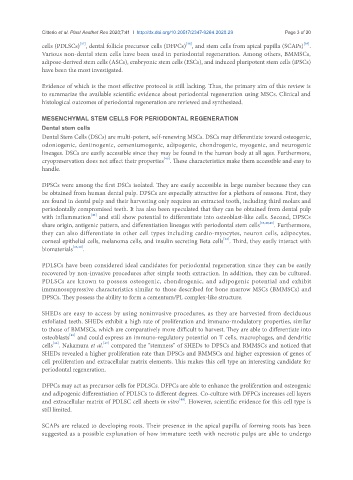Page 459 - Read Online
P. 459
Citterio et al. Plast Aesthet Res 2020;7:41 I http://dx.doi.org/10.20517/2347-9264.2020.29 Page 3 of 20
[39]
[38]
[37]
cells (PDLSCs) , dental follicle precursor cells (DFPCs) , and stem cells from apical papilla (SCAPs) .
Various non-dental stem cells have been used in periodontal regeneration. Among others, BMMSCs,
adipose-derived stem cells (ASCs), embryonic stem cells (ESCs), and induced pluripotent stem cells (iPSCs)
have been the most investigated.
Evidence of which is the most effective protocol is still lacking. Thus, the primary aim of this review is
to summarize the available scientific evidence about periodontal regeneration using MSCs. Clinical and
histological outcomes of periodontal regeneration are reviewed and synthesized.
MESENCHYMAL STEM CELLS FOR PERIODONTAL REGENERATION
Dental stem cells
Dental Stem Cells (DSCs) are multi-potent, self-renewing MSCs. DSCs may differentiate toward osteogenic,
odontogenic, dentinogenic, cementumogenic, adipogenic, chondrogenic, myogenic, and neurogenic
lineages. DSCs are easily accessible since they may be found in the human body at all ages. Furthermore,
cryopreservation does not affect their properties . These characteristics make them accessible and easy to
[40]
handle.
DPSCs were among the first DSCs isolated. They are easily accessible in large number because they can
be obtained from human dental pulp. DPSCs are especially attractive for a plethora of reasons. First, they
are found in dental pulp and their harvesting only requires an extracted tooth, including third molars and
periodontally compromised teeth. It has also been speculated that they can be obtained from dental pulp
[41]
with inflammation and still show potential to differentiate into osteoblast-like cells. Second, DPSCs
share origin, antigenic pattern, and differentiation lineages with periodontal stem cells [35,40,41] . Furthermore,
they can also differentiate in other cell types including cardio-myocytes, neuron cells, adipocytes,
corneal epithelial cells, melanoma cells, and insulin secreting Beta cells . Third, they easily interact with
[42]
biomaterials [43,44] .
PDLSCs have been considered ideal candidates for periodontal regeneration since they can be easily
recovered by non-invasive procedures after simple tooth extraction. In addition, they can be cultured.
PDLSCs are known to possess osteogenic, chondrogenic, and adipogenic potential and exhibit
immunosuppressive characteristics similar to those described for bone marrow MSCs (BMMSCs) and
DPSCs. They possess the ability to form a cementum/PL complex-like structure.
SHEDs are easy to access by using noninvasive procedures, as they are harvested from deciduous
exfoliated teeth. SHEDs exhibit a high rate of proliferation and immuno-modulatory properties, similar
to those of BMMSCs, which are comparatively more difficult to harvest. They are able to differentiate into
osteoblasts and could express an immuno-regulatory potential on T cells, macrophages, and dendritic
[45]
[47]
[46]
cells . Nakamura et al. compared the “stemness” of SHEDs to DPSCs and BMMSCs and noticed that
SHEDs revealed a higher proliferation rate than DPSCs and BMMSCs and higher expression of genes of
cell proliferation and extracellular matrix elements. This makes this cell type an interesting candidate for
periodontal regeneration.
DFPCs may act as precursor cells for PDLSCs. DFPCs are able to enhance the proliferation and osteogenic
and adipogenic differentiation of PDLSCs to different degrees. Co-culture with DFPCs increases cell layers
[48]
and extracellular matrix of PDLSC cell sheets in vitro . However, scientific evidence for this cell type is
still limited.
SCAPs are related to developing roots. Their presence in the apical papilla of forming roots has been
suggested as a possible explanation of how immature teeth with necrotic pulps are able to undergo

